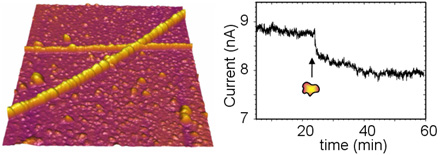Nanotube biosensors
Biosensors based on a carbon-nanotube transistors are similar to the
MOSFET transistors that drive modern computers. In both types
of transistors, the conductivity of a channel is enhanced or diminished by
the presence of nearby electrical charge. In the MOSFET transistor,
nearby charge sits on a "gate", turning a silicon channel "on" and
"off". In a nanotube biosensor, the nearby charge is a molecule in aqueous
solution and the channel is a semiconducting carbon nanotube.

(above) Two carbon nanotubes have been coated with IgG proteins. The resistance of the nanotubes changes over time as the protein molecules stick to the surface. Using this effect, we can monitor binding kinetics and surface coverage. Such devices are being adapted for testing how well drugs bind to their targets, and for sensing disease markers at ultra-low concentrations. For more images from our research see the image gallery.
Biosensor research
Molecular machines - the proteins responsible for the processes of life - are driven by electrostatic forces. To get an intuitive picture of protein dynamics in living cells, I recommend a 3 minute animatation recently produced by Harvard University (a written narration for the movie is also available). When charge is shifted around a protein by chemical reactions, electrostatic forces change the protein conformation. These conformational changes facilitate everything from ion channel switching to DNA replication. A better understanding of the changing electrostatic environment in proteins is one of many challenging and rewarding long-term goals in biosensor research.
The development of biosensors using charge-sensitive nano-materials is an exciting new field. Many important advances have been made in the last five years. Both carbon nanotube [1] and silicon nanowire [2] devices have been adapted for biological detection.
Biosensor research offers the opportunity to explore the interplay between effects known from physics, chemistry and biology. Ideas from the quantum theory of solids are needed to understand how bandstructure, temperature and intrinsic noise affect the detection sensitivity. Our understanding of charged molecules in solution takes ideas from chemistry (for example, the effect of pH on charge state) and statistical mechanics (the description of ion clouds which surround charged molecules). And, from the field of biophysics, we continue to learn more about protein structure and dynamics through tools such as x-ray crystallography, NMR and computer modeling.
[1] Besteman et al. Nanoletters 3, 727 (2003)
[2] Cui et al. Science 293, 1289 (2001)
